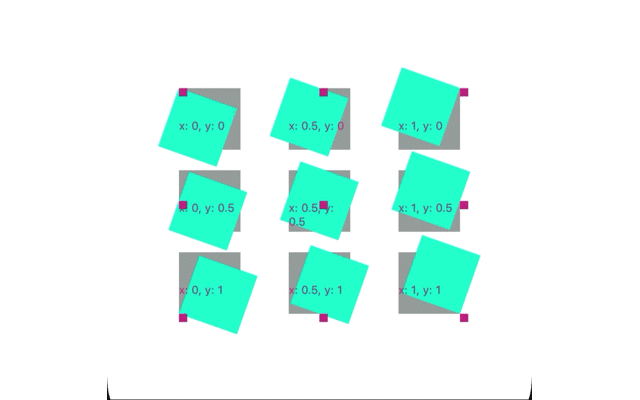React Native transforms with pivot point
I just made a withAnchorPoint function to make transform working with anchor point easier in react-native. https://github.com/sueLan/react-native-anchor-point.
You can use it like this:
import { withAnchorPoint } from 'react-native-anchor-point';
getTransform = () => {
let transform = {
transform: [{ perspective: 400 }, { rotateX: rotateValue }],
};
return withAnchorPoint(transform, { x: 0.5, y: 0 }, { width: CARD_WIDTH, height: CARD_HEIGHT });
};
<Animated.View style={[styles.blockBlue, this.getTransform()]} />
I also wrote an article for it.

The following tricky codes are to set the anchor point or called pivot point of a view.
- translate the view by x, y, z on the x-axis, y-axis, z-axis
- apply rotation
- translate the view back by -x, -y, -z on the x-axis, y-axis, z-axis
translateX: -w / 2
rotateY
translateX: w / 2
This means setting the anchor point as (0, 0.5). We apply it in the transform style like this
const transform = {
transform: [
{translateX: -w / 2},
rotateY,
{translateX: w / 2}
]
}
return (
<Animated.View style={transform}></Animated.View>
)
}
translateX: w / 2
rotateY
translateX: -w / 2
This means setting the anchor point as (1, 0.5)
translateX: -w / 2
translateY: -h / 2
rotateZ
translateX: w / 2
translateY: h / 2
This means setting the anchor point as (0, 0)
translateX: w / 2
translateY: h / 2
rotateZ
translateX: -w / 2
translateX: -h / 2
This means setting the anchor point as (1, 1)
In iOS, it is called anchor point. About the anchorPoint
layer.anchorPoint = CGPointMake(0, 0)
In Android, it is called pivot point.
viewToMove.setPivotX(0);
viewToMove.setPivotY(0);
React Native Animated Rotation Anchor Point
I figured it out after a lot of tinkering. I looked up multiple other resources and they all used the shifting like i mentioned in my question.
<Animated.View
style={[
styles.test,
{ transform: [
{ translateY: containerHeight / 2 },
{ rotate: rotateInterpolator },
{ translateY: -(containerHeight / 2) }
]
},
]}
>
<Text style={{ color: "white" }}>Test</Text>
</Animated.View>
Rotate View/Image around specific point, not center (React Native)
So I finally found a way and formular to calculate the offset. The desired point of rotation gets obviously rotated as well, when applying an angle to the object. So what I had to do was getting the position of this point (lets call it pRotated) by using rotationmatrices with the position of both the center (m) of the object and the desired point of rotation (p) like this:
angle = alpha * (Math.PI / 180)
pRotated.x = m.x + (p.x - m.x) * Math.cos(angle) - (p.y - m.y) * Math.sin(angle)
pRotated.y = m.y + (p.x - m.x) * Math.sin(angle) + (p.y - m.y) * Math.cos(angle)
Then it was easy to get the offset using
translateX = pRotated.x - p.x
translateY = pRotated.y - p.y
which then can just be applied to the object, and then its rotated by alpha around point p.
I've attached a scribble for further explanation.
Why does the transform-origin CSS property not show up in React?
As spotted by wintvelt, there was a spurious parenthesis in my code:
el.style.transformOrigin = `${100}px ${100}px`;
is correct.
Related Topics
Make Text in Select Element Wrap When Too Long
CSS Fluid Layout: Margin-Top Based on Percentage Grows When Container Width Increases
:Last-Child Pseudo Class Selector in CSS and Internet Explorer
What Is That Thing Between CSS "Selectors" Called
How to Change a Background Image Opacity Without Changing on Div Content
What Is Device Pixel Ratio For
IE6 "Frame" Layout with 100% Height and Scrollbars
Why Do Professional-Made Websites Have Odd #Id and .Class Names
CSS Attribute Selector for Non-Empty Attributes
How to Make a Link Inside a Div Fill the Entire Space Inside the Div
Font-Weight Is Not Working Properly
Css: How Is Height of Block-Elements Calculated
Input[Type=Number] Placeholder Color in Ff29+